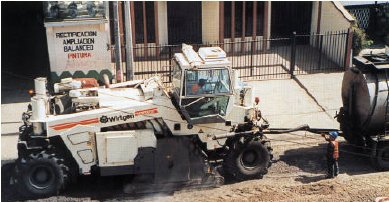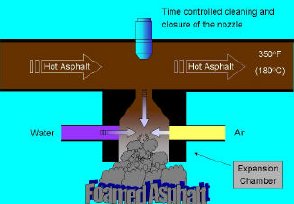FHWA Resource Center
PAVEMENT AND MATERIALS TEAM
Innovative Technology
What is Foamed Asphalt?
Michael Smith, Materials Engineer
Foamed
Asphalt is a stabilization technique used widely throughout Europe. However,
the European process is relatively new here in the United States. The
scanning team
found significant advances have occurred in the construction equipment
used to apply
foamed asphalt. These advances allow for deep road base stabilization
at low cost
compared to other stabilization techniques.
The European foamed asphalt stabilization technique involves the following
construction
activities:
1) pulverization of the existing road surface,
2) shaping the surface to near final grade,
3) mixing and injection of foamed asphalt cement,
4) compaction to final grade.
The preferred method is to initially pulverize the existing road bed without
injection of
asphalt cement. This allows the contractor the opportunity to adjust the
grade to its near
final profile prior to mixing and injection. During the mixing and injection
process hot
paving grade asphalt cement is foamed or expanded and injected into the
chamber of
the remixing unit. A schematic of the mixing chamber is shown in Figure
1. An asphalt
nurse truck, shown in Figure 2, is required to feed hot asphalt cement
to the remixing
unit.
Foamed asphalt depends on the forceful expansion of asphalt cement. As
shown in
Figure 3, expansion of the asphalt cement is obtained by the addition
of a small amount
of water. Air may be used if working with harder paving grade asphalts.
The hot
reaction is similar to the addition of water to hot oil. However, in the
foamed process this
reaction is controlled. Precisely added amounts of water control the rate
and amount
foamed asphalt. In the expansion process small droplets of asphalt are
forced into the
pulverized materials. As opposed to conventional paving techniques, the
purpose is not
to coat the particles but to bind the pulverized materials together. The
process has been
compared to spot welding. The foamed asphalt has an attraction to the
fines due to the
high surface area. This creates a mortar-like paste that provides the
strength and
cohesion of the mix after compaction. The trick is to use the correct
amount of water to
achieve optimum expansion into the pulverized material. Expansion of the
asphalt occurs
in specially designed spray nozzles.
Following the mixing process, a rubber tired roller may be used as the
breakdown roller
followed by a steel wheel roller as the finish roller. The result is a
cost effective deep
strength road base.
Some of the benefits
of foamed asphalt over more traditional stabilization techniques
include:
· stockpile material for longer periods of time (as long as 1 month)
· achieve deeper road stabilization (as deep as 14 inches)
· open roads to traffic faster
Three manufacturers have been identified that produce foamed asphalt equipment.
These
include CMI, Catepillar Paving, and Wirtgen. The team scanning team visited
the
Wirtgen Facilities in Germany. Wirtgen has made 147 machines in the last
five years. 5
are in the U.S., 2 in Canada, and the others around the world.
Scan Findings
Carlton we need your notes here. We were introduced to the process in
Germany at the
Wirtgen facilities. However, I do not have records of use in the other
countries we
visited. Perhaps the other scan members do. Perhaps the Wirtgen officials
can supply
European useage information.
Contrast with United States
Foamed asphalt has been used sporadically since the late 1960s in the
United States.
Research has been conducted at Iowa State University and the Waterways
Experiment
Station in Mississippi. Later, Conoco owned the patent to the process.
The process did
not catch on due to difficulties in foaming the asphalt cement. Limited
demonstrations
have been conducted in this country. In the 1980s projects were placed
in Colorado and
Wyoming. Demonstration projects have been constructed using the newer
European
process as recently as 1998 in Jefferson County Wisconsin. There is a
need to evaluate
the effectiveness of these projects.
(Photos and Figures are below)

Figure 1. Illustration Showing How Foamed Asphalt is Applied Inside
the Mixing Chamber.

Figure 3. Illustration Showing How Foamed Asphalt Works.>

Figure 1. The Wirtgen 2500 Is Used to Both Pulverize the Road Bed and
Apply the Foamed Asphalt.

